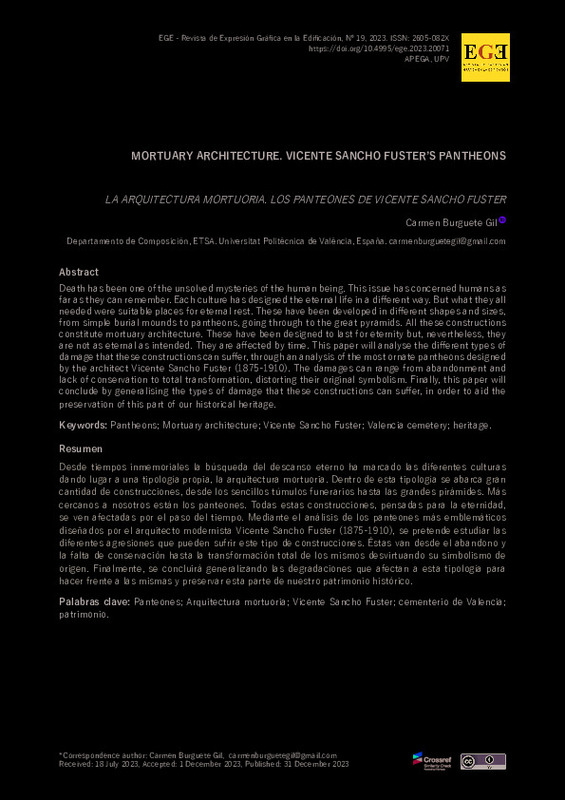JavaScript is disabled for your browser. Some features of this site may not work without it.
Buscar en RiuNet
Listar
Mi cuenta
Estadísticas
Ayuda RiuNet
Admin. UPV
Mortuary architecture. Vicente Sancho Fuster’s pantheons
Mostrar el registro sencillo del ítem
Ficheros en el ítem
| dc.contributor.author | Burguete Gil, Carmen
|
es_ES |
| dc.coverage.spatial | east=-0.3964525; north=39.4475212; name=Cementerio de Valencia, Espanya | es_ES |
| dc.date.accessioned | 2024-01-04T11:48:43Z | |
| dc.date.available | 2024-01-04T11:48:43Z | |
| dc.date.issued | 2023-12-27 | |
| dc.identifier.issn | 1888-8143 | |
| dc.identifier.uri | http://hdl.handle.net/10251/201486 | |
| dc.description.abstract | [EN] Death has been one of the unsolved mysteries of the human being. This issue has concerned humans as far as they can remember. Each culture has designed the eternal life in a different way. But what they all needed were suitable places for eternal rest. These have been developed in different shapes and sizes, from simple burial mounds to pantheons, going through to the great pyramids. All these constructions constitute mortuary architecture. These have been designed to last for eternity but, nevertheless, they are not as eternal as intended. They are affected by time. This paper will analyse the different types of damage that these constructions can suffer, through an analysis of the most ornate pantheons designed by the architect Vicente Sancho Fuster (1875-1910). The damages can range from abandonment and lack of conservation to total transformation, distorting their original symbolism. Finally, this paper will conclude by generalising the types of damage that these constructions can suffer, in order to aid the preservation of this part of our historical heritage. | es_ES |
| dc.description.abstract | [ES] Desde tiempos inmemoriales la búsqueda del descanso eterno ha marcado las diferentes culturas dando lugar a una tipología propia, la arquitectura mortuoria. Dentro de esta tipología se abarca gran cantidad de construcciones, desde los sencillos túmulos funerarios hasta las grandes pirámides. Más cercanos a nosotros están los panteones. Todas estas construcciones, pensadas para la eternidad, se ven afectadas por el paso del tiempo. Mediante el análisis de los panteones más emblemáticos diseñados por el arquitecto modernista Vicente Sancho Fuster (1875-1910), se pretende estudiar las diferentes agresiones que pueden sufrir este tipo de construcciones. Éstas van desde el abandono y la falta de conservación hasta la transformación total de los mismos desvirtuando su simbolismo de origen. Finalmente, se concluirá generalizando las degradaciones que afectan a esta tipología para hacer frente a las mismas y preservar esta parte de nuestro patrimonio histórico. | es_ES |
| dc.language | Español | es_ES |
| dc.language | Inglés | es_ES |
| dc.publisher | Universitat Politècnica de València | es_ES |
| dc.relation.ispartof | EGE Revista de Expresión Gráfica en la Edificación | es_ES |
| dc.rights | Reconocimiento (by) | es_ES |
| dc.subject | Panteones | es_ES |
| dc.subject | Arquitectura mortuoria | es_ES |
| dc.subject | Vicente Sancho Fuster | es_ES |
| dc.subject | Cementerio de Valencia | es_ES |
| dc.subject | Patrimonio | es_ES |
| dc.subject | Pantheons | es_ES |
| dc.subject | Mortuary architecture | es_ES |
| dc.subject | Valencia cemetery | es_ES |
| dc.subject | Heritage | es_ES |
| dc.title | Mortuary architecture. Vicente Sancho Fuster’s pantheons | es_ES |
| dc.title.alternative | La arquitectura mortuoria. Los panteones de Vicente Sancho Fuster | es_ES |
| dc.type | Artículo | es_ES |
| dc.identifier.doi | 10.4995/ege.2023.20071 | |
| dc.rights.accessRights | Abierto | es_ES |
| dc.description.bibliographicCitation | Burguete Gil, C. (2023). Mortuary architecture. Vicente Sancho Fuster’s pantheons. EGE Revista de Expresión Gráfica en la Edificación. (19):4-19. https://doi.org/10.4995/ege.2023.20071 | es_ES |
| dc.description.accrualMethod | OJS | es_ES |
| dc.relation.publisherversion | https://doi.org/10.4995/ege.2023.20071 | es_ES |
| dc.description.upvformatpinicio | 4 | es_ES |
| dc.description.upvformatpfin | 19 | es_ES |
| dc.type.version | info:eu-repo/semantics/publishedVersion | es_ES |
| dc.description.issue | 19 | es_ES |
| dc.identifier.eissn | 2605-082X | |
| dc.relation.pasarela | OJS\20071 | es_ES |








